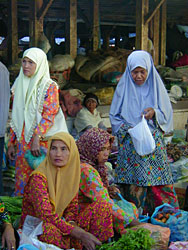Buluh
Kubu Central Market
 Kelantan's Central Market
is one of the most vibrant and enjoyable sites in the country. The
sights, sounds, and colours are uniquely Kelantanese--women traders
display brilliantly-coloured fresh graden produce, food stands grill
delectable barbecued chicken, and craftsmen offer traditional wares
like Kelantanese silver rose bowls. Kelantan's Central Market
is one of the most vibrant and enjoyable sites in the country. The
sights, sounds, and colours are uniquely Kelantanese--women traders
display brilliantly-coloured fresh graden produce, food stands grill
delectable barbecued chicken, and craftsmen offer traditional wares
like Kelantanese silver rose bowls.
In Kota
Bharu
Cultural Centre
Here, visitors to Kota Bharu,
the capital of Kelantan, can view the traditional
arts of Kelantan, including kiteflying, rebana (giant drums), silat
(martial arts), giant top spinning, wayang kulit (shadow play).
Located in Jalan Mahmood near Perdana Hotel, the Cultural Centre is open from
February to October except during the fasting month.
Gunung
Stong
Kelantan's highest mountain at 1,422 metres. Located here is Gua Ikan (Fish
Cave). Its name is derived from a lone rock that looks like a fish. To cave
explorers on an expedition, part of the lure is trying to find a pot of gold
believed to have been hidden during the Japanese Occupation.
Museum
of Royal Traditions and Customs
Built in 1887 by Sultan Muhammad II for his grandson Long Kundur, this former
palace, Istana Jahar, is now a museum of cultural history. The intricate wood
carvings are testimony to the superb craftsmanship of the Kelantanese. Photographs,
artifacts and exhibits on Kelantan's rich cultural heritage will keep visitors
enthralled.
Masjid
Kampung Laut
Believed to be one of the oldest mosques in Malaysia. The mosque was actually
dismantled and rebuilt piece by piece from its original site at Kampung Laut
because floods from the nearby river threatened its structure. The mosque was
built entirely without the use of nails. It is located at Nilam Puri.
Wat Photivihan
Jambu
The shrine of the largest reclining Buddha in South-East Asia is situated in
the village of Kg Jambu, 12 km north of Kota Bharu.
Merdeka
Square
Previously known as Padang Kelupang, Merdeka Square is one of many such central
civic spaces in Malaysia. The British built most of the country's padangs as
central open spaces around which revolved the buildings, and the life, of the
colonial administration. When Malaysia declared its independence on 31 August
1957, the square was renamed Merdeka Square.
|
 Kelantan's Central Market
is one of the most vibrant and enjoyable sites in the country. The
sights, sounds, and colours are uniquely Kelantanese--women traders
display brilliantly-coloured fresh graden produce, food stands grill
delectable barbecued chicken, and craftsmen offer traditional wares
like Kelantanese silver rose bowls.
Kelantan's Central Market
is one of the most vibrant and enjoyable sites in the country. The
sights, sounds, and colours are uniquely Kelantanese--women traders
display brilliantly-coloured fresh graden produce, food stands grill
delectable barbecued chicken, and craftsmen offer traditional wares
like Kelantanese silver rose bowls.